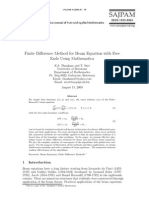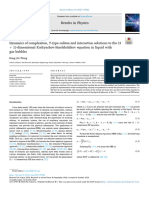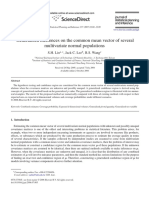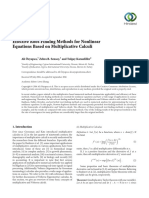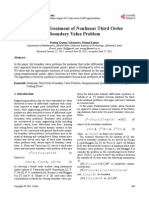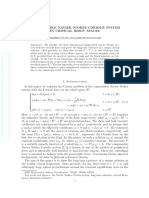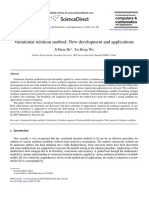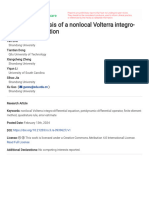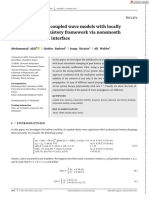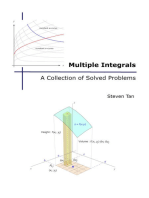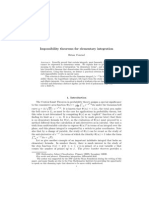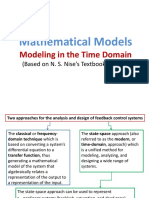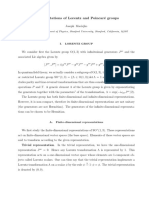Apm 2023081115272169
Apm 2023081115272169
Uploaded by
saadaouiimCopyright:
Available Formats
Apm 2023081115272169
Apm 2023081115272169
Uploaded by
saadaouiimOriginal Title
Copyright
Available Formats
Share this document
Did you find this document useful?
Is this content inappropriate?
Copyright:
Available Formats
Apm 2023081115272169
Apm 2023081115272169
Uploaded by
saadaouiimCopyright:
Available Formats
Advances in Pure Mathematics, 2023, 13, 495-503
https://www.scirp.org/journal/apm
ISSN Online: 2160-0384
ISSN Print: 2160-0368
Existence and Uniqueness Results for a Fully
Third-Order Boundary Value Problem
Xiaoming Liu, Yongxiang Li*
Department of Mathematics, Northwest Normal University, Lanzhou, China
How to cite this paper: Liu, X.M., and Li, Abstract
Y.X. (2023) Existence and Uniqueness
Results for a Fully Third-Order Boundary The boundary value problems of the third-order ordinary differential equa-
Value Problem. Advances in Pure Mathe- tion have many practical application backgrounds and their some special cas-
matics, 13, 495-503. es have been studied by many authors. However, few scholars have studied
https://doi.org/10.4236/apm.2023.138033
the boundary value problems of the complete third-order differential equa-
Received: July 13, 2023 tions u ′′′ ( t ) = f ( t , u ( t ) , u ′ ( t ) , u ′′ ( t ) ) . In this paper, we discuss the existence
Accepted: August 11, 2023
Published: August 14, 2023
and uniqueness of solutions and positive solutions of the fully third-order or-
dinary differential equation on [ 0,1] with the boundary condition
Copyright © 2023 by author(s) and
Scientific Research Publishing Inc.
( 0 ) u=
u= ′ (1) u ′′=
(1) 0 . Under some inequality conditions on nonlinearity f
This work is licensed under the Creative some new existence and uniqueness results of solutions and positive solutions
Commons Attribution International are obtained.
License (CC BY 4.0).
http://creativecommons.org/licenses/by/4.0/
Keywords
Open Access
Fully Third-Order BVP, Solution, Positive Solution, Existence and
Uniqueness, Inequality Conditions
1. Introduction and Main Results
In this paper we discuss existence of solutions for third-order boundary value
problem (BVP) with fully nonlinear term
=u ′′′ ( t ) f ( t , u ( t ) , u ′ ( t ) , u ′′ ( t ) ) , t ∈ I ,
(1.1)
( 0 ) u=
u= ′ (1) u ′′= (1) 0,
where I = [ 0,1] , f : I × 3 → is a continuous nonlinearity.
The boundary value problems of the third-order ordinary differential equa-
tion have many practical application backgrounds. They appear in many differ-
ent areas of applied mathematics and physics, such as the deflection of the
curved beam with constant or variable cross section, the three-layer beam, elec-
DOI: 10.4236/apm.2023.138033 Aug. 14, 2023 495 Advances in Pure Mathematics
X. M. Liu, Y. X. Li
tromagnetic wave or gravity driven flows, etc. [1] [2]. These problems have at-
tracted the attention of many authors, and some theorems and methods of non-
linear functional analysis have been applied to research the solvability of these
problems, such as the topological transversality [3], the monotone iterative tech-
nique [4] [5] [6], the method of upper and lower solutions [7] [8] [9], Le-
ray-Schauder degree [10] [11] [12] [13], the fixed point theory of increasing op-
erator [14] [15], the fixed-point theorem of Guo-Krasnoselskii’s cone expansion
or compression type [16] [17] [18] [19].
However, most of the above work is about the special case of that nonlinearity
f that does not contain derivative term u ′ or u ′′ , only a few authors consider
the case with fully nonlinear term. Recently, the authors of Reference [20] consi-
dered the fully third-order BVP (1.1) and they showed when nonlinearity
f ( t , x, y, z ) is nonnegative and superlinear or sublinear growth on ( x, y, z ) at
origin and infinity, BVP (1.1) has at least one positive solution by using the fixed
point index theory in cones. In this paper, we will use different methods to es-
tablish the existence and uniqueness results of solution and positive solution for
general BVP (1.1) under some simple inequality conditions without restriction
of the growth of nonlinearity.
Let r > 0 be a constant. We define two domains of 3 by
r r
Dr ( x, y, z ) | x ≤ , y ≤ , z ≤ r ,
= (1.2)
6 2
r r
=Dr+ ( x, y, z ) | 0 ≤ x ≤ , 0 ≤ y ≤ , − r ≤ z ≤ 0 . (1.3)
6 2
Let f : I × 3 → be continuous and set
= {
f r max f ( t , x, y, z ) | t ∈ I , ( x, y, z ) ∈ Dr , } (1.4)
=f r+ max { f ( t , x, y, z ) | t ∈ I , ( x, y, z ) ∈ D }. +
r (1.5)
Our main results are as follows:
Theorem 1.1. Let f : I × 3 → be continuous. If there exists a constant
r > 0 such that f r ≤ r , then BVP (1.1) has a solution u satisfies
( u ( t ) , u′ ( t ) , u′′ ( t ) ) ∈ D ,
r t ∈ I. (1.6)
Theorem 1.2. Under the assumptions of Theorem 1.1, if f satisfies the fol-
lowing Lipschtz type condition in Dr
(H1) there exist constants a0 , a1 , a2 ≥ 0 restricted by
a0 a1
+ + a2 < 1, (1.7)
6 2
such that
f ( t , x2 , y2 , z2 ) − f ( t , x1 , y1 , z1 ) ≤ a0 x2 − x1 + a1 y2 − y1 + a2 z2 − z1 , (1.8)
for any t ∈ I and ( x1 , y1 , z1 ) , ( x2 , y2 , z2 ) ∈ Dr , then BVP (1.1) has a unique so-
lution satisfies (1.6).
Let R=+
[0, ∞ ) , R − = ( −∞,0] . When nonlinearity f is nonnegative, we have
DOI: 10.4236/apm.2023.138033 496 Advances in Pure Mathematics
X. M. Liu, Y. X. Li
the following existence theorems of positive solution:
Theorem 1.3. Let f : I × + × + × − → + be continuous. If there exists a
constant r > 0 such that f r+ ≤ r , then BVP (1.1) has a solution u satisfies
( u ( t ) , u′ ( t ) , u′′ ( t ) ) ∈ D
+
r , t ∈ I. (1.9)
Theorem 1.4. Under the assumptions of Theorem 1.3, if there exist constants
a0 , a1 , a2 ≥ 0 restricted by (1.7) such that f satisfies the Lipschtz condition (1.8)
in Dr+ , then BVP (1.1) has a unique solution satisfies (1.9).
Note that (1.9) implies u ( t ) ≥ 0 for every t ∈ I , and hence it is a positive
solution of BVP (1.1).
If f satisfies that
fr
liminf < 1, (1.10)
r →∞ r
we easily verify that for any R > 0 , there exists r > R such that f r < r . Hence
by Theorem 1.1, we have:
Corollary 1.5. If f : I × 3 → be continuous and satisfies (1.10), BVP (1.1)
has at least one solution.
Similarly, by Theorem 1.3, we have:
Corollary 1.6. Let f : I × + × + × − → + be continuous and satisfy
f r+
liminf < 1. (1.11)
r →∞ r
Then BVP (1.1) has at least one positive solution.
The proof of Theorems 1.1 - 1.4 will be given in next section. Some applica-
tions and examples are presented in Section 3 to illustrate the applicability of our
results.
2. Proof of the Main Results
Let C ( I ) denote the Banach space of all continuous function u ( t ) on I with
norm u C = max t∈I u ( t ) . Generally for n ∈ , we use C n ( I ) to denote the
Banach space of all nth-order continuous differentiable function on I with the
{
norm u C n = max u C , u ′ C ,, u ( n )
C
}
. Let C + ( I ) be the cone of nonnega-
tive functions in C ( I ) .
To discuss BVP (1.1), we first consider the corresponding linear boundary
value problem (LBVP)
u ′′′ ( t ) h ( t ) ,
= t ∈ I,
(2.1)
( 0 ) u=
u= ′ (1) u ′′=
(1) 0.
where h ∈ C ( I ) is a given function.
Lemma 2.1. For every h ∈ C ( I ) , LBVP (2.1) has a unique solution
u=: Sh ∈ C 3 ( I ) , which satisfies
1 1
u ≤ h , u′ C ≤ h , u ′′ C ≤ h C . (2.2)
C
6 C 2 C
Moreover, the solution operator S : C ( I ) → C 3 ( I ) is a bounded linear opera-
DOI: 10.4236/apm.2023.138033 497 Advances in Pure Mathematics
X. M. Liu, Y. X. Li
tor. When h ∈ C + ( I ) , the solution of LBVP (2.1) satisfies
u ( t ) ≥ 0, u ′ ( t ) ≥ 0, u ′′ ( t ) ≤ 0, t ∈ I . (2.3)
Proof. Let h ∈ C ( I ) . Integrating the Equation (2.1), we obtain that
t 1 1 1
u (t ) =
∫0 τ dτ ∫τ h ( s ) ds + ∫t t dτ ∫τ h ( s ) ds :=
Sh ( t ) , t ∈ I . (2.4)
by this expression we have
1 1
=u′ ( t ) ∫t dτ ∫τ h ( s ) ds, t ∈ I,
1
u ′′ ( t ) =
− ∫t h ( s ) ds, t ∈ I , (2.5)
u ′′′ ( t ) h ( t ) , t ∈ I .
=
Hence u ∈ C 3 ( I ) is a unique solution of LBVP (2.1). For every t ∈ I , by (2.4)
and (2.5), we have
t 1 1 1
u ( t ) ≤ ∫0 τ dτ ∫τ h ( s ) ds + ∫t t dτ ∫τ h ( s ) ds
t 1
≤ ∫0 τ (1 − τ ) dτ h C
+ ∫t t (1 − τ ) dτ h C
=
1
6
(
1 − (1 − t ) h
3
) C
1
≤ h C,
6
1 1 1
u ′ ( t ) ≤ ∫t dτ ∫τ h ( s ) ds ≤ ∫t (1 − τ ) dτ h C
1 1
≤ (1 − t ) h
2
≤ h C,
2 C
2
1
u ′′ ( t ) ≤ ∫t h ( s ) ds ≤ (1 − t ) h C
≤ h C,
u ′′′ ( t ) ≤ h ( t ) ≤ h C .
This means that (2.2) holds and
Sh=
C3
u C3
≤ h C.
Hence S : C ( I ) → C 3 ( I ) is bounded. When h ∈ C + ( I ) , by (2.4) and (2.5), (2.3)
holds.
Proof of Theorem 1.1. Define a mapping F : C ( I ) → C ( I ) by
2
=F ( u )( t ) : f ( t , u ( t ) , u ′ ( t ) , u ′′ ( t ) ) , t ∈ I . (2.6)
Then by the continuity of f, F : C 2 ( I ) → C ( I ) is continuous and it maps every
bounded in C 2 ( I ) into a bounded set in C ( I ) . By the compactness of the
embedding C 3 ( I ) ↪ C 2 ( I ) , the solution operator of LBVP (2.1)
S : C ( I ) → C 2 ( I ) is completely continuous. Hence, the composition operator
of S and F
=A : S F :C 2 ( I ) → C 2 ( I ) (2.7)
is completely continuous. By the definitions of S and F, the solution of BVP (1.1)
is equivalent to the fixed point of A. We use the Schauder fixed point theorem to
show A has a fixed u satisfied (1.6).
For the positive constant r in Theorem 1.1, define a bounded subset of
DOI: 10.4236/apm.2023.138033 498 Advances in Pure Mathematics
X. M. Liu, Y. X. Li
C 2 ( I ) by
r r
Ω r = u ∈ C 2 ( I ) | u ≤ , u ′ C ≤ , u ′′ C ≤ r . (2.8)
C
6 2
Clearly, Ω r is convex and closed in C 2 ( I ) . We show that
A(Ω
= r) S ( F ( Ωr ) ) ⊂ Ωr . (2.9)
For any u ∈ Ω r , set h = F ( u ) . Then h ∈ C ( I ) and
= ( F ( u ) ) Sh . By
Au S=
the definitions of Ω r and Dr , u satisfies
( u ( t ) , u′ ( t ) , u′′ ( t ) ) ∈ D ,r t ∈ I.
For every t ∈ I , by the definition of f r , we obtain that
h ( t ) F ( u=
= )( t ) f ( t , u ( t ) , u ′ ( t ) , u ′′ ( t ) ) ≤ f r ≤ r , (2.10)
and hence h C ≤ r . By this and (2.2) of Lemma 2.1, Au= Sh ∈ Ω r . Thus (2.9)
holds. By the Schauder fixed point theorem, A has a fixed u in Ω r . By the defi-
nition of Ω r , u satisfies (1.6) and it is a solution of BVP (1.1).
Proof of Theorem 1.2. By Theorem 1.1, BVP (1.1) has at least one solution
satisfies (1.6). Let u1 , u2 ∈ C 3 ( I ) be two solutions of BVP (1) satisfied (1.6). Then
u1 = S ( F ( u1 ) ) , u2 = S ( F ( u2 ) ) . Set u
= u2 − u1 and
= h F ( u2 ) − F ( u1 ) . Then
u = S ( F ( u2 ) ) − S ( F ( u2 ) ) = S ( F ( u2 ) − F ( u2 ) ) = Sh.
By the definition of the operator S, u is the solution of LBVP (2.1). Hence, u = Sh
satisfies (2.2). By the assumption (H1) and (2.2), for every t ∈ I , we have
h ( t ) F ( u2 )( t ) − F ( u1 )( t )
=
= f ( t , u2 ( t ) , u2′ ( t ) , u2′′ ( t ) ) − f ( t , u1 ( t ) , u1′ ( t ) , u1′′( t ) )
≤ a0 u2 ( t ) − u1 ( t ) + a1 u2′ ( t ) − u1′ ( t ) + a2 u2′′ ( t ) − u1′′( t )
≤ a0 u2 − u1 C
+ a1 u2′ − u1′ C
+ a2 u2′′ − u1′′ C
= a0 u C
+ a1 u ′ C + a2 u ′′ C
a a
= 0 + 1 + a2 h C .
6 2
From this it follows that
a a
h ≤ 0 + 1 + a2 h C . (2.11)
C
6 2
This implies that h C = 0 , so that = u Sh = 0 . Hence u2 = u1 . This means BVP
(1.1) has only one solution satisfied (1.6).
Proof of Theorem 1.3. Define a closed convex cone of C ( I ) by
2
{
K = u ∈ C 2 ( I ) | u ( t ) ≥ 0, u ′ ( t ) ≥ 0, u ′′ ( t ) ≤ 0, t ∈ I . } (2.12)
By the continuity of f : I × + × + × − → + , the mapping F : K → C + ( I )
defined by (2.6) is continuous and it maps every bounded in K into a bounded
set in C + ( I ) . By (2.3), the solution operator S of BVP (2.1) satisfies
DOI: 10.4236/apm.2023.138033 499 Advances in Pure Mathematics
X. M. Liu, Y. X. Li
( )
S C + ( I ) ⊂ K. (2.13)
Hence, the composition operator
= A S F : K → K is completely continuous.
Set
Ω +r =Ω r ∩ K . (2.14)
Then Ω +r is a bounded closed convex set in C 2 ( I ) . Similar to the proof of
(2.9), we can obtain that
( )
A Ω
= +
r ( ( )) ⊂ Ω .
S F Ω +r +
r (2.15)
Therefore, by the Schauder fixed point theorem, A has a fixed u in Ω r+ . By the
definition of Ω +r , u satisfies (1.9) and is a solution of BVP (1.1).
Proof of Theorem 1.4. The existence of a solution satisfied (1.9) is guaran-
teed by Theorem 1.3. Let u1 , u2 ∈ C 3 ( I ) be two solutions of BVP (1) satisfied
(1.9). Then u1 , u2 ∈ Ω +r and u1 = S ( F ( u1 ) ) , u2 = S ( F ( u2 ) ) . Set u
= u2 − u1
=
and h F ( u2 ) − F ( u1 ) . Then h ∈ C ( I ) and u = Sh . Similar to the argument
in Theorem 1.2, we can prove that h satisfies (2.11). From (2.11) it follows that
h = 0 . So we have = u Sh = 0 , that is u1 = u2 . Hence BVP (1.1) has a unique
solution satisfied (1.9).
3. Applications
In this section, we use the main results obtained in Section 1 to deduce some
concrete existence and uniqueness theorems for some third-order boundary
value problems.
Firstly, our main results can be applied to BVP (1.1) under the nonlinearity
f ( t , x, y, z ) is linear growth on x, y and z.
Theorem 3.1. Let f : I × 3 → be continuous and satisfy the following li-
near growth condition.
(H2) there exist constants a0 , a1 , a2 ≥ 0 restricted by (1.7) and c > 0 , such
that
f ( t , x, y, z ) ≤ a0 x + a1 y + a2 z + c, ( t , x, y , z ) ∈ I × 3 . (3.1)
Then BVP (1.1) has at least one solution.
Proof. For r > 0 , when t ∈ I and ( x, y, z ) ∈ Dr , by (3.1) and the definition
of Dr , we have
a a
f ( t , x, y, z ) ≤ a0 x + a1 y + a2 z + c ≤ 0 + 1 + a2 r + c.
6 2
Hence, by (1.4) and (1.7) we have
f r a0 a1 c a a
≤ + + a2 + → 0 + 1 + a2 < 1, r → ∞. (3.2)
r 6 2 r 6 2
fr
Hence when r large enough, < 1 , and the assumption of Theorem 1.1 is satis-
r
fied. By Theorem 1.1, BVP (1.1) has at least one solution.
In Theorem 3.1, when f is nonnegative, any solution u of BVP (1.1) is positive.
DOI: 10.4236/apm.2023.138033 500 Advances in Pure Mathematics
X. M. Liu, Y. X. Li
In fact, since= h F ( u ) ∈ C + ( I ) , by Lemma= ( F ( u ) ) Sh satisfies
2.1, u S=
(2.2), and u is a positive solution of BVP(1.1). That is:
Corollary 3.2. Let f : I × 3 → + be continuous and satisfy the assumption
(H2). Then BVP (1.1) has at least one positive solution.
Strengthening the condition of Theorem 3.1, we have the following unique-
ness result:
Theorem 3.3. Let f : I × 3 → be continuous and satisfy the following
global Lipschitz condition.
(H3) there exist constants a0 , a1 , a2 ≥ 0 restricted by (1.7) such that
f ( t , x2 , y2 , z2 ) − f ( t , x1 , y1 , z1 ) ≤ a0 x2 − x1 + a1 y2 − y1 + a2 z2 − z1 , (3.3)
for any t ∈ I and ( x1 , y1 , z1 ) , ( x2 , y2 , z2 ) ∈ 3 , Then BVP (1.1) has a unique so-
lution.
Proof. For any t ∈ I and ( x, y, z ) ∈ 3 , in Condition (H3) choosing
( x2 , y2 , z2 ) = ( x, y, z ) , ( x1 , y1 , z1 ) = ( 0,0,0 ) , and setting
=c max t∈I f ( t ,0,0,0 ) + 1 , we obtain that (H1) holds. By Theorem 1.1, BVP (1.1)
has at least one solution.
By (3.2), there exists R0 > 0 such that f r < r for r > R0 . Let u1 , u2 ∈ C 3 ( I )
be two solutions of BVP (1). Setting
{
r1 = max 6 u1 C
, 2 u1′ C , u1′′ C ,}
(3.4)
r2 = max {6 u 2 C , 2 u2′ C
, u ′′ } ,
2 C
and choosing r > max { R0 , r1 , r2 } , we have
r r
f r < r and ui ≤ , ui′ ≤ , ui′′ C ≤ r , i =
1, 2. (3.5)
C
6 C
2
Hence u1 and u2 satisfy (1.6). By the uniqueness conclusion of Theorem 1.2,
u1 = u2 . Hence BVP (1.1) has a unique solution.
By Theorem 3.3 and Corollary 3.2, we have:
Corollary 3.4. Let f : I × 3 → + be continuous and satisfy the assumption
(H3). Then BVP (1.1) has a unique positive solution.
Secondly, our main results can be also applied to BVP (1.1) with superlinear
growth nonlinearity f.
Example 3.1. Consider the following superlinear third-order boundary value
problem
′′′ 1
u ( t ) =u ( t ) + u ′ ( t ) + u ( t ) u ′′ ( t ) + sin πt , t ∈ [ 0,1] ,
2 2 2
6 (3.6)
(
u= 0 ) u=′ (1 ) u ′′
= (1 ) 0.
Corresponding to BVP (1.1), the nonlinearity is
1
f ( t , x, y, z ) = x 2 + y 2 + xz 2 + sin πt , (3.7)
6
which is superlinear on x, y and z. We verify that f satisfies the condition of
Theorem 1.3 for r = 1 .
For every t ∈ I and ( x, y, z ) ∈ D1+ , by (3.7)
DOI: 10.4236/apm.2023.138033 501 Advances in Pure Mathematics
X. M. Liu, Y. X. Li
1 1 1 1 17
0 ≤ f ( t , x, y , z ) ≤ + + + = < 1. (3.8)
36 4 2 6 18
Hence f1+ ≤ 1 . That is, f satisfies the condition of Theorem 1.3 for r = 1 . By
Theorem 1.3, BVP (3.6) has at least one positive solution.
It should be noted that this existence result of BVP (3.6) can not be obtained
from ([20], Theorem 1.1), since the corresponding nonlinearity f does not satisfy
the Condition (F1) of ([20], Theorem 1.1).
Funding
This research is supported by NNSFs of China (12061062, 11661071).
Conflicts of Interest
The authors declare that they have no conflicts of interest.
References
[1] Greguš, M. (1987) Third Order Linear Differential Equations. Reidel, Dordrecht.
[2] Greguš, M. (1994) Two Sorts of Boundary-Value Problems of Nonlinear Third Or-
der Differential Equations. Archivum Mathematicum, 30, 285-292.
http://dml.cz/dmlcz/107515
[3] O’Regan, D.J. (1987) Topological Transversality: Application to Third-Order Boun-
dary Value Problems. SIAM Journal on Mathematical Analysis, 18, 630-641.
https://doi.org/10.1137/0518048
[4] Omari, P. and Trombetta, M. (1992) Remarks on the Lower and Upper Solutions
Method for Second and Third-Order Periodic Boundary Value Problems. Applied
Mathematics and Computation, 50, 1-21.
https://doi.org/10.1016/0096-3003(92)90007-N
[5] Cabada, A. (1994) The Method of Lower and Upper Solutions for Second, Third,
Forth, and Higher Order Boundary Value Problems. Journal of Mathematical Anal-
ysis and Applications, 185, 302-320. https://doi.org/10.1006/jmaa.1994.1250
[6] Cabada, A. (1995) The Method of Lower and Upper Solutions for Third-Order Peri-
odic Boundary Value Problems. Journal of Mathematical Analysis and Applications,
195, 568-589. https://doi.org/10.1006/jmaa.1995.1375
[7] Cabada, A. and Lois, S. (1999) Existence of Solution for Discontinuous Third Order
Boundary Value Problems. Journal of Computational and Applied Mathematics, 110,
105-114. https://doi.org/10.1016/S0377-0427(99)00199-5
[8] Cabada, A., Grossinho, M.R. and Minhos, F. (2003) On the Solvability of Some Dis-
continuous Third Order Nonlinear Differential Equations with Two Point Boundary
Conditions. Journal of Mathematical Analysis and Applications, 285, 174-190.
https://doi.org/10.1016/S0022-247X(03)00388-3
[9] Grossinho, M.R. and Minhós, F.M. (2001) Existence Result for Some Third Order Se-
parated Boundary Value Problems. Nonlinear Analysis: Theory, Methods & Applica-
tions, 47, 2407-2418. https://doi.org/10.1016/S0362-546X(01)00364-9
[10] Grossinho, M.R., Minhos, F.M. and Santos, A.I. (2005) Solvability of Some Third-
Order Boundary Value Problems with Asymmetric Unbounded Nonlinearities. Non-
linear Analysis: Theory, Methods & Applications, 62, 1235-1250.
https://doi.org/10.1016/j.na.2005.04.029
DOI: 10.4236/apm.2023.138033 502 Advances in Pure Mathematics
X. M. Liu, Y. X. Li
[11] Grossinho, M.R., Minhos, F.M. and Santos, A.I. (2005) Existence Result for a Third-
Order ODE with Nonlinear Boundary Conditions in Presence of a Sign-Type Nagumo
Control. Journal of Mathematical Analysis and Applications, 309, 271-283.
https://doi.org/10.1016/j.jmaa.2005.01.030
[12] Du, Z., Ge, W. and Lin, X. (2004) Existence of Solutions for a Class of Third-Order
Nonlinear Boundary Value Problems. Journal of Mathematical Analysis and Appli-
cations, 294, 104-112. https://doi.org/10.1016/j.jmaa.2004.02.001
[13] Benmezai, A., Henderson, J. and Meziani, M. (2013) A Third Order Boundary Val-
ue Problem with Jumping Nonlinearities. Nonlinear Analysis: Theory, Methods &
Applications, 77, 33-44. https://doi.org/10.1016/j.na.2012.08.018
[14] Yao, Q. and Feng, Y. (2002) The Existence of Solutions for a Third Order Two-Point
Boundary Value Problem. Applied Mathematics Letters, 15, 227-232.
https://doi.org/10.1016/S0893-9659(01)00122-7
[15] Feng, Y. and Liu, S. (2005) Solvability of a Third-Order Two-Point Boundary Value
Problem. Applied Mathematics Letters, 18, 1034-1040.
https://doi.org/10.1016/j.aml.2004.04.016
[16] Li, S.H. (2006) Positive Solutions of Nonlinear Singular Third-Order Two-Point
Boundary Value Problem. Journal of Mathematical Analysis and Applications, 323,
413-425. https://doi.org/10.1016/j.jmaa.2005.10.037
[17] Sun, Y.P. (2005) Positive Solutions of Singular Third-Order Three-Point Boundary
Value Problem. Journal of Mathematical Analysis and Applications, 306, 589-603.
https://doi.org/10.1016/j.jmaa.2004.10.029
[18] Liu, Z., Ume, J.S. and Kang, S.M. (2007) Positive Solutions of a Singular Nonlinear
Third Order Two-Point Boundary Value Problem. Journal of Mathematical Analy-
sis and Applications, 326, 589-601. https://doi.org/10.1016/j.jmaa.2006.03.030
[19] Feng, X. and Feng, H. (2022) Existence and Multiplicity of Positive Solutions for a
Singular Third-Order Three-Point Boundary Value Problem with a Parameter. Jour-
nal of Applied Mathematics and Physics, 10, 1146-1157.
https://doi.org/10.4236/jamp.2022.104080
[20] Li, Y.X. and Li, Y.H. (2017) Positive Solutions of a Third-Order Boundary Value
Problem with Full Nonlinearity. Mediterranean Journal of Mathematics, 14, Article
No. 128. https://doi.org/10.1007/s00009-017-0928-4
DOI: 10.4236/apm.2023.138033 503 Advances in Pure Mathematics
You might also like
- Dong 等 - 2023 - Convergence to Nonlinear Diffusion Waves for SolutNo ratings yetDong 等 - 2023 - Convergence to Nonlinear Diffusion Waves for Solut37 pages
- Energy_decay_for_a_viscoelastic_Kirchhoff_plate_eqNo ratings yetEnergy_decay_for_a_viscoelastic_Kirchhoff_plate_eq17 pages
- An Efficient Iterative Technique for SolNo ratings yetAn Efficient Iterative Technique for Sol6 pages
- Global Attractors For Nonlinear Wave Equations With Linear Dissipative TermsNo ratings yetGlobal Attractors For Nonlinear Wave Equations With Linear Dissipative Terms13 pages
- Boundary Value Problem For A Loaded Fractional Diffusion EquationNo ratings yetBoundary Value Problem For A Loaded Fractional Diffusion Equation11 pages
- SAMSA Journal Vol 4 Pp61 78 Thankane StysNo ratings yetSAMSA Journal Vol 4 Pp61 78 Thankane Stys17 pages
- Dynamics of Complexiton Y Type Soliton and Interaction Solutio - 2023 - ResultsNo ratings yetDynamics of Complexiton Y Type Soliton and Interaction Solutio - 2023 - Results9 pages
- Large-Time Asymptotics For Solutions of A Generalized Burgers Equation With Variable ViscosityNo ratings yetLarge-Time Asymptotics For Solutions of A Generalized Burgers Equation With Variable Viscosity23 pages
- Large Deviation Principle For Reflected Stochastic Diffe 2023 Statistics PNo ratings yetLarge Deviation Principle For Reflected Stochastic Diffe 2023 Statistics P12 pages
- Journal of Mathematical Analysis and Applications: Guangying LV, Mingxin WangNo ratings yetJournal of Mathematical Analysis and Applications: Guangying LV, Mingxin Wang13 pages
- An Intermixed Method For Solving The Combination of Mixed Variational Inequality Problems and Fixed-Point ProblemsNo ratings yetAn Intermixed Method For Solving The Combination of Mixed Variational Inequality Problems and Fixed-Point Problems30 pages
- Darboux Integrable 3d Lotka Volterra SystemNo ratings yetDarboux Integrable 3d Lotka Volterra System19 pages
- Poisson Percolation On The Oriented Square Lattice: SciencedirectNo ratings yetPoisson Percolation On The Oriented Square Lattice: Sciencedirect15 pages
- Full Discretization of Wave Equation: Boundary Value Problems December 2015No ratings yetFull Discretization of Wave Equation: Boundary Value Problems December 201512 pages
- Convergence analysis of sectional methods for solvingNo ratings yetConvergence analysis of sectional methods for solving23 pages
- JSRS-21-026 Kyritsis - Corrected - 29 - 9 - 22No ratings yetJSRS-21-026 Kyritsis - Corrected - 29 - 9 - 229 pages
- Surface Plasmon Resonance SPR Theory TutorialNo ratings yetSurface Plasmon Resonance SPR Theory Tutorial34 pages
- The Quasi-Boundary Value Regularization Method For Identifying The Initial Value With Discrete Random NoiseNo ratings yetThe Quasi-Boundary Value Regularization Method For Identifying The Initial Value With Discrete Random Noise12 pages
- On The Backward Problem For Parabolic Equations With MemoryNo ratings yetOn The Backward Problem For Parabolic Equations With Memory19 pages
- Research Article: Effective Root-Finding Methods For Nonlinear Equations Based On Multiplicative CalculiNo ratings yetResearch Article: Effective Root-Finding Methods For Nonlinear Equations Based On Multiplicative Calculi8 pages
- An Overview On Tools From Functional Analysis: Matthias Augustin, Sarah Eberle, and Martin GrothausNo ratings yetAn Overview On Tools From Functional Analysis: Matthias Augustin, Sarah Eberle, and Martin Grothaus35 pages
- Some Mean Square Integral Inequalites Involving The Beta Function and Generalized Convex Stochatic ProcessesNo ratings yetSome Mean Square Integral Inequalites Involving The Beta Function and Generalized Convex Stochatic Processes10 pages
- Bulletin of London Math Soc - 2024 - Esposito - Notes on overdetermined singular problemsNo ratings yetBulletin of London Math Soc - 2024 - Esposito - Notes on overdetermined singular problems10 pages
- Free Vibration Analysis of A Uniform CanNo ratings yetFree Vibration Analysis of A Uniform Can13 pages
- Numerical Treatment of Nonlinear Third Order Boundary Value ProblemNo ratings yetNumerical Treatment of Nonlinear Third Order Boundary Value Problem6 pages
- Survival Probability For Super Brownian Motion 2022 Statistics ProbabilitNo ratings yetSurvival Probability For Super Brownian Motion 2022 Statistics Probabilit9 pages
- Some Integral Inequalities Involving The K-Beta Function and Related PropertiesNo ratings yetSome Integral Inequalities Involving The K-Beta Function and Related Properties16 pages
- Compressible Navier-Stokes-Coriolis System in Critical Besov SpacesNo ratings yetCompressible Navier-Stokes-Coriolis System in Critical Besov Spaces39 pages
- He2007 Variational Iteration Method New Development and ApplicationsNo ratings yetHe2007 Variational Iteration Method New Development and Applications14 pages
- Higher-Order Ordinary Differential Equations: 3.1 Boundary and Initial ConditionsNo ratings yetHigher-Order Ordinary Differential Equations: 3.1 Boundary and Initial Conditions32 pages
- Numerical Analysis of A Nonlocal Volterra IntegroNo ratings yetNumerical Analysis of A Nonlocal Volterra Integro24 pages
- Galerkin-Finite Element Method For The Numerical SNo ratings yetGalerkin-Finite Element Method For The Numerical S13 pages
- Math Methods in App Sciences - 2023 - ShahNo ratings yetMath Methods in App Sciences - 2023 - Shah21 pages
- Global Attractivity For Reaction-Diffusion EquatioNo ratings yetGlobal Attractivity For Reaction-Diffusion Equatio17 pages
- Vol4 Iss3 350-360 A Minimax Inequality For A Class ofNo ratings yetVol4 Iss3 350-360 A Minimax Inequality For A Class of12 pages
- Stability Results of Coupled Wave Models With Locally Memory in A Past History Framework Via Nonsmooth Coefficients On The InterfaceNo ratings yetStability Results of Coupled Wave Models With Locally Memory in A Past History Framework Via Nonsmooth Coefficients On The Interface32 pages
- Ordinary Differential Equations and Stability Theory: An IntroductionFrom EverandOrdinary Differential Equations and Stability Theory: An IntroductionNo ratings yet
- Impossibility Theorems For Elementary Integration: Brian ConradNo ratings yetImpossibility Theorems For Elementary Integration: Brian Conrad13 pages
- Sudoku 1: Profesores: Mauricio J. Suárez Ledesma y Antonia Ferreira MartínezNo ratings yetSudoku 1: Profesores: Mauricio J. Suárez Ledesma y Antonia Ferreira Martínez6 pages
- Solving The Schrodinger Equation Directly For A Particle in One-Dimensional Periodic PotentialsNo ratings yetSolving The Schrodinger Equation Directly For A Particle in One-Dimensional Periodic Potentials23 pages
- 1.1 Trig Ratios in Right Triangles Part 1No ratings yet1.1 Trig Ratios in Right Triangles Part 15 pages
- Lesson Plan in Mathematics 10: School Grade Level Teacher Learning Area Teaching Dates and Time Quarter100% (1)Lesson Plan in Mathematics 10: School Grade Level Teacher Learning Area Teaching Dates and Time Quarter4 pages
- Exponential Fourier Series: Scope and Background ReadingNo ratings yetExponential Fourier Series: Scope and Background Reading16 pages
- Notes Important Questions Answers of 11th Math Chapter 12 Exercise 12.5No ratings yetNotes Important Questions Answers of 11th Math Chapter 12 Exercise 12.56 pages
- Limits WBJEE Crash Course: Q1 2022 (Paper 1)No ratings yetLimits WBJEE Crash Course: Q1 2022 (Paper 1)22 pages
- (MATH2350) (2018) (F) Midterm Schenci 74056No ratings yet(MATH2350) (2018) (F) Midterm Schenci 7405611 pages
- SMK Kampong Selamat Formative Test 2 Mathematics Form 2 Time: 1 HoursNo ratings yetSMK Kampong Selamat Formative Test 2 Mathematics Form 2 Time: 1 Hours6 pages
- 3.1 Quadratic Expression and Equation IINo ratings yet3.1 Quadratic Expression and Equation II1 page
- Dong 等 - 2023 - Convergence to Nonlinear Diffusion Waves for SolutDong 等 - 2023 - Convergence to Nonlinear Diffusion Waves for Solut
- Energy_decay_for_a_viscoelastic_Kirchhoff_plate_eqEnergy_decay_for_a_viscoelastic_Kirchhoff_plate_eq
- Global Attractors For Nonlinear Wave Equations With Linear Dissipative TermsGlobal Attractors For Nonlinear Wave Equations With Linear Dissipative Terms
- Boundary Value Problem For A Loaded Fractional Diffusion EquationBoundary Value Problem For A Loaded Fractional Diffusion Equation
- Dynamics of Complexiton Y Type Soliton and Interaction Solutio - 2023 - ResultsDynamics of Complexiton Y Type Soliton and Interaction Solutio - 2023 - Results
- Large-Time Asymptotics For Solutions of A Generalized Burgers Equation With Variable ViscosityLarge-Time Asymptotics For Solutions of A Generalized Burgers Equation With Variable Viscosity
- Large Deviation Principle For Reflected Stochastic Diffe 2023 Statistics PLarge Deviation Principle For Reflected Stochastic Diffe 2023 Statistics P
- Journal of Mathematical Analysis and Applications: Guangying LV, Mingxin WangJournal of Mathematical Analysis and Applications: Guangying LV, Mingxin Wang
- An Intermixed Method For Solving The Combination of Mixed Variational Inequality Problems and Fixed-Point ProblemsAn Intermixed Method For Solving The Combination of Mixed Variational Inequality Problems and Fixed-Point Problems
- Poisson Percolation On The Oriented Square Lattice: SciencedirectPoisson Percolation On The Oriented Square Lattice: Sciencedirect
- Full Discretization of Wave Equation: Boundary Value Problems December 2015Full Discretization of Wave Equation: Boundary Value Problems December 2015
- Convergence analysis of sectional methods for solvingConvergence analysis of sectional methods for solving
- The Quasi-Boundary Value Regularization Method For Identifying The Initial Value With Discrete Random NoiseThe Quasi-Boundary Value Regularization Method For Identifying The Initial Value With Discrete Random Noise
- On The Backward Problem For Parabolic Equations With MemoryOn The Backward Problem For Parabolic Equations With Memory
- Research Article: Effective Root-Finding Methods For Nonlinear Equations Based On Multiplicative CalculiResearch Article: Effective Root-Finding Methods For Nonlinear Equations Based On Multiplicative Calculi
- An Overview On Tools From Functional Analysis: Matthias Augustin, Sarah Eberle, and Martin GrothausAn Overview On Tools From Functional Analysis: Matthias Augustin, Sarah Eberle, and Martin Grothaus
- Some Mean Square Integral Inequalites Involving The Beta Function and Generalized Convex Stochatic ProcessesSome Mean Square Integral Inequalites Involving The Beta Function and Generalized Convex Stochatic Processes
- Bulletin of London Math Soc - 2024 - Esposito - Notes on overdetermined singular problemsBulletin of London Math Soc - 2024 - Esposito - Notes on overdetermined singular problems
- Numerical Treatment of Nonlinear Third Order Boundary Value ProblemNumerical Treatment of Nonlinear Third Order Boundary Value Problem
- Survival Probability For Super Brownian Motion 2022 Statistics ProbabilitSurvival Probability For Super Brownian Motion 2022 Statistics Probabilit
- Some Integral Inequalities Involving The K-Beta Function and Related PropertiesSome Integral Inequalities Involving The K-Beta Function and Related Properties
- Compressible Navier-Stokes-Coriolis System in Critical Besov SpacesCompressible Navier-Stokes-Coriolis System in Critical Besov Spaces
- He2007 Variational Iteration Method New Development and ApplicationsHe2007 Variational Iteration Method New Development and Applications
- Higher-Order Ordinary Differential Equations: 3.1 Boundary and Initial ConditionsHigher-Order Ordinary Differential Equations: 3.1 Boundary and Initial Conditions
- Galerkin-Finite Element Method For The Numerical SGalerkin-Finite Element Method For The Numerical S
- Global Attractivity For Reaction-Diffusion EquatioGlobal Attractivity For Reaction-Diffusion Equatio
- Vol4 Iss3 350-360 A Minimax Inequality For A Class ofVol4 Iss3 350-360 A Minimax Inequality For A Class of
- Stability Results of Coupled Wave Models With Locally Memory in A Past History Framework Via Nonsmooth Coefficients On The InterfaceStability Results of Coupled Wave Models With Locally Memory in A Past History Framework Via Nonsmooth Coefficients On The Interface
- Ordinary Differential Equations and Stability Theory: An IntroductionFrom EverandOrdinary Differential Equations and Stability Theory: An Introduction
- Invariant Manifold Theory for Hydrodynamic TransitionFrom EverandInvariant Manifold Theory for Hydrodynamic Transition
- Multiple Integrals, A Collection of Solved ProblemsFrom EverandMultiple Integrals, A Collection of Solved Problems
- Impossibility Theorems For Elementary Integration: Brian ConradImpossibility Theorems For Elementary Integration: Brian Conrad
- Sudoku 1: Profesores: Mauricio J. Suárez Ledesma y Antonia Ferreira MartínezSudoku 1: Profesores: Mauricio J. Suárez Ledesma y Antonia Ferreira Martínez
- Solving The Schrodinger Equation Directly For A Particle in One-Dimensional Periodic PotentialsSolving The Schrodinger Equation Directly For A Particle in One-Dimensional Periodic Potentials
- Lesson Plan in Mathematics 10: School Grade Level Teacher Learning Area Teaching Dates and Time QuarterLesson Plan in Mathematics 10: School Grade Level Teacher Learning Area Teaching Dates and Time Quarter
- Exponential Fourier Series: Scope and Background ReadingExponential Fourier Series: Scope and Background Reading
- Notes Important Questions Answers of 11th Math Chapter 12 Exercise 12.5Notes Important Questions Answers of 11th Math Chapter 12 Exercise 12.5
- SMK Kampong Selamat Formative Test 2 Mathematics Form 2 Time: 1 HoursSMK Kampong Selamat Formative Test 2 Mathematics Form 2 Time: 1 Hours









